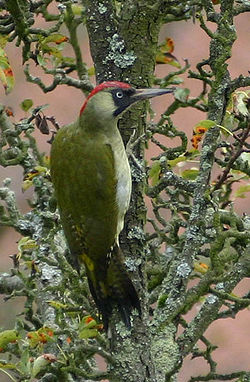| Picus | |
|---|---|
 | |
| A female European green woodpecker (Picus viridis) | |
| Scientific classification | |
| Kingdom: | Animalia |
| Phylum: | Chordata |
| Class: | Aves |
| Order: | Piciformes |
| Family: | Picidae |
| Tribe: | Picini |
| Genus: | Picus Linnaeus, 1758 |
| Type species | |
| Picus viridis Linnaeus, 1758 | |
| Species | |
see list | |
| Synonyms | |
Gecinus [1] | |
Picus is a genus of birds in the woodpecker family. It has representatives in Europe, Asia and North Africa. The genus name is Latin for "woodpecker". The genus Picus was erected by the Swedish naturalist Carl Linnaeus in 1758 in the tenth edition of his Systema Naturae .
Contents
These are large woodpeckers, typically with green upperparts. They are found in forests or more open woodland, and lay their white eggs in a tree hole nest, typically on a bed of wood chips. Picus woodpeckers are primarily insect eaters, with several species specialising in taking ants or termites. Some species will also consume fruit or eggs. Insects are captured by a rapid outward flick of the long tongue and gummed to its tip by sticky saliva. This genus is less completely arboreal than some other woodpecker groups, and its members often feed on the ground, attacking anthills or termitaries.




















